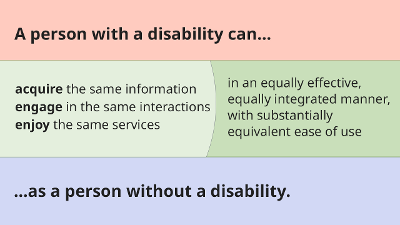Showing results 61-70 of 207 for Materials Accessibility
Search results
-
Presentation
4:15PM – 5:30PM MT on Monday, June 3, 2024
Join this session to gain insight on easy-to-implement techniques that can help the busy educator vet apps for accessibility quickly to decide which ones should be loved (and kept) and which ones should be…listed (as in passed on)! Learn to direct your limited resources to those apps that will better meet the needs of all of your learners.
-
Many students with disabilities encounter barriers when using text-based materials, whether in print or digital. Learn about the actions that need to be taken so that learners who need accessible formats of these materials receive them with high quality and in a timely manner.
-
Presentation

2:30PM – 4:00PM ET on Tuesday, April 25, 2023
In this session, the term “accessible formats” will be clearly defined, and participants will be guided through a four-step process for providing and supporting their use in general education.
-
Join our upcoming webinar series AEMing for Access, focusing on accessibility, accessible educational materials, accessible and assistive technologies! By registering just once, you'll gain access to participate in every webinar in the series and receive timely reminders.
-
Podcast

National AEM Center at CAST, 2021
In the conclusion of our three-part series exploring the history of accessibility at CAST, co-founders Skip Stahl and David Rose reflect on how that history continues to inspire and inform the work of the technical assistance centers based at CAST.
-
The purpose of the Quality Indicators and Critical Components is to assist state and local education agencies, institutions of higher education and workforce development agencies with planning, implementing, and evaluating dynamic, coordinated systems for the timely provision of accessible educational materials and accessible technologies.
-

Review key terms that will be helpful for you to know to get the most from the information on this website.
-

Explore the coordinating systems needed for K-12 and learn how to develop or revise a K-12 system to address best practices for the provision of accessible materials and technologies.
-

Explore the coordinating systems needed for Early Childhood and learn how to develop or revise an early childhood system to include best practices for the provision of accessible materials and technologies.
-

Selecting accessible formats is the second step in a multi-step decision-making process.
